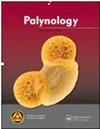大戟属植物花粉形态及其系统意义
IF 1.3
4区 地球科学
Q3 PALEONTOLOGY
引用次数: 0
摘要
摘要本研究的目的是利用LM和SEM分析27个不同土耳其大胡属(Euphorbia L. Turkish)类群的花粉形态。此外,本研究还发展了主成分分析(PCA),并使用聚类分析来检验相似性分组。结果表明,在大戟属植物的24个分类群中存在三聚体花粉粒,而在大戟属植物的3个分类群中存在小齿花粉粒。和东方菊的花粉粒为三柱体和三柱体。本研究结果还揭示了花粉粒经常具有穿孔模式。使用网状和规则穿孔表面的装饰也被发现。本研究发现,大戟属植物中有6个类群花粉形态为长球状,而27个类群中有20个类群花粉形态为扁球状。但是,在27个大戟属分类群中,只有1个大戟属(E. grisophylla)的花粉具有近长形。另一方面,PCA结果解释了92.16%的变异,UPGMA树形图的非加权对群法(unweighted pair group method with arithmetic mean, UPGMA)鉴定出4个分类类群,分别为:1 ~ 4本文章由计算机程序翻译,如有差异,请以英文原文为准。
Pollen Morphology of Some Euphorbia Taxa and Its Systematic Significance
ABSTRACT The current study's objective is to infer the specific pollen morphologies of 27 different Euphorbia L. Turkish taxa were cultivated using LM and SEM. Additionally, principal component analysis (PCA) is developed and cluster analysis is used to examine similarity grouping in this study. The results of the current study showed that tricolporate pollen grains are present in 24 different taxa of Euphorbia, whereas three other taxa E. denticulate, E. esula subsp. tommassiniana, and E. orientalis have tricolpate and tricolporate pollen grains. The results of this study also revealed that pollen grains frequently have a perforated pattern. The use of ornamentations with reticulate- and rugulate-perforate surfaces has also been discovered. The current study revealed that six taxa of Euphorbia have prolate-spheroidal pollen shapes, while 20 of the 27 Euphorbia under study have oblate-spheroidal pollen shapes. But only the pollen of E. grisophylla, 1 of the 27 tested Euphorbia taxa, has a subprolate shape. On the other hand, the PCA results explained 92.16% of the variation, and the unweighted pair group method with arithmetic mean (UPGMA) dendrogram identified four taxonomic groupings, as follows: t es 1–4
求助全文
通过发布文献求助,成功后即可免费获取论文全文。
去求助
来源期刊

Palynology
地学-古生物学
CiteScore
3.40
自引率
26.70%
发文量
48
审稿时长
>12 weeks
期刊介绍:
Palynology is an international journal, and covers all aspects of the science. We accept papers on both pre-Quaternary and Quaternary palynology and palaeobotany. Contributions on novel uses of palynology, review articles, book reviews, taxonomic studies and papers on methodology are all actively encouraged.
 求助内容:
求助内容: 应助结果提醒方式:
应助结果提醒方式:


